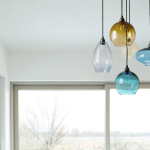
Sustainable and recyclable lamps are lighting options that are designed with the environment in mind. These lamps are made from materials that can be easily recycled or biodegraded, and they are energy-efficient, reducing the amount of electricity needed to power them. Making eco-friendly choices in lighting is important because traditional lamps contribute to environmental issues such as energy consumption, greenhouse gas emissions, and waste generation. By choosing sustainable and recyclable lamps, individuals can reduce their carbon footprint and contribute to a more sustainable future.
The Importance of Sustainable Lighting
The impact of lighting on the environment cannot be underestimated. Traditional lamps, such as incandescent bulbs, consume a significant amount of energy and contribute to greenhouse gas emissions. In fact, lighting accounts for about 15% of global electricity consumption. By switching to sustainable lighting options, individuals can significantly reduce their energy consumption and carbon footprint.
In addition to reducing energy consumption, sustainable lighting also offers a range of benefits. LED lamps, for example, have a longer lifespan compared to traditional bulbs, which means they need to be replaced less frequently. This not only saves money but also reduces waste generation. Furthermore, sustainable lighting options often produce less heat, which can help reduce the need for air conditioning and further decrease energy consumption.
Understanding the Environmental Impact of Lamps
Energy consumption and greenhouse gas emissions are two major environmental impacts associated with traditional lamps. Incandescent bulbs, for example, convert only about 10% of the energy they consume into light, while the rest is wasted as heat. This inefficiency contributes to higher energy consumption and increased greenhouse gas emissions.
Disposal and waste management are also important considerations when it comes to lamps. Traditional lamps contain hazardous materials such as mercury, which can be harmful if not disposed of properly. When these lamps end up in landfills, the mercury can leach into the soil and water, posing a threat to human health and the environment. Sustainable lamps, on the other hand, are made from materials that can be easily recycled or biodegraded, reducing the amount of waste generated.
Different Types of Sustainable Lamps
There are several types of sustainable lamps available on the market today. LED lamps, for example, are highly energy-efficient and have a longer lifespan compared to traditional bulbs. They use up to 80% less energy and can last up to 25 times longer. Solar-powered lamps are another sustainable option, as they harness the power of the sun to generate electricity. These lamps are ideal for outdoor lighting and can be used in gardens, pathways, and other areas where access to electricity is limited.
Energy-efficient lamps, such as compact fluorescent lamps (CFLs), are also a popular choice for sustainable lighting. These lamps use about 75% less energy than incandescent bulbs and can last up to 10 times longer. Biodegradable lamps are another innovative option that is gaining popularity. These lamps are made from natural materials that can be easily broken down by microorganisms, reducing waste generation.
Benefits of Choosing Sustainable Lamps
Choosing sustainable lamps offers a range of benefits for both individuals and the environment. One of the most significant benefits is lower energy bills. Sustainable lamps consume less energy, which translates into lower electricity costs over time. LED lamps, for example, may have a higher upfront cost but can save individuals hundreds of dollars in energy bills over their lifespan.
Reducing one’s carbon footprint is another important benefit of choosing sustainable lamps. By using less energy and emitting fewer greenhouse gases, individuals can contribute to mitigating climate change and preserving the environment for future generations. Sustainable lamps also have a longer lifespan compared to traditional bulbs, which means they need to be replaced less frequently. This reduces waste generation and saves resources.
Factors to Consider When Choosing Sustainable Lamps

When choosing sustainable lamps, there are several factors to consider. Wattage and brightness are important considerations, as they determine the amount of light produced by the lamp. It is important to choose a lamp that provides the desired level of brightness while consuming the least amount of energy.
Color temperature is another factor to consider. Different lamps produce different colors of light, ranging from warm white to cool white. The color temperature can affect the ambiance and mood of a space, so it is important to choose a lamp that suits the desired lighting effect.
Compatibility with fixtures is also an important consideration. Some lamps may not fit certain fixtures or may require additional accessories for installation. It is important to ensure that the chosen lamp is compatible with existing fixtures or that appropriate modifications can be made.
Price and affordability are also important factors to consider. While sustainable lamps may have a higher upfront cost compared to traditional bulbs, they often offer long-term savings in terms of energy consumption and lifespan. It is important to weigh the upfront cost against the potential savings over time.
Recyclable Lamp Options
Recyclable lamps are designed with materials that can be easily recycled or biodegraded at the end of their lifespan. These lamps are made from materials such as glass, aluminum, and plastic, which can be recycled into new products. Proper disposal and recycling methods are important to ensure that these lamps do not end up in landfills, where they can contribute to environmental pollution.
When disposing of recyclable lamps, it is important to separate them from other waste and take them to designated recycling centers. These centers have the necessary equipment and processes to safely recycle the lamps and recover valuable materials. It is also important to follow any specific instructions provided by the manufacturer or local authorities regarding the disposal of recyclable lamps.
Sustainable Lighting Trends and Innovations
The lighting industry is constantly evolving, with new trends and innovations emerging all the time. One of the most significant trends in sustainable lighting is the development of smart lighting systems. These systems use advanced technology to control and optimize lighting, reducing energy consumption and improving efficiency. Smart lighting systems can be programmed to automatically adjust brightness and color temperature based on the time of day or user preferences.
Light-emitting diodes (LEDs) are another major innovation in sustainable lighting. LEDs are highly energy-efficient and have a longer lifespan compared to traditional bulbs. They are also available in a wide range of colors and can be dimmed to create different lighting effects. Solar-powered lamps are also gaining popularity, especially in areas with limited access to electricity. These lamps harness the power of the sun to generate electricity, making them a sustainable and cost-effective lighting option.
Tips for Maintaining Sustainable Lamps
Proper maintenance and care are important for ensuring the longevity and efficiency of sustainable lamps. Regular cleaning is essential to remove dust and dirt that can accumulate on the lamp’s surface and reduce its brightness. It is important to use a soft cloth or brush to avoid scratching the lamp.
Proper storage and handling are also important considerations. Lamps should be stored in a cool, dry place away from direct sunlight and extreme temperatures. It is also important to handle lamps with care, avoiding dropping or mishandling them, as this can damage the lamp and reduce its lifespan.
Upgrading and replacing old lamps is another important aspect of maintaining sustainable lighting. As technology advances, new lamps with improved energy efficiency and performance become available. It is important to regularly assess existing lamps and consider upgrading or replacing them with more sustainable options when necessary.
Making the Switch to Sustainable Lighting
In conclusion, making eco-friendly choices in lighting is crucial for reducing energy consumption, greenhouse gas emissions, and waste generation. Sustainable and recyclable lamps offer a range of benefits, including lower energy bills, reduced carbon footprint, and longer lifespan. When choosing sustainable lamps, it is important to consider factors such as wattage, brightness, color temperature, compatibility with fixtures, and price. Proper disposal and recycling methods should also be followed for recyclable lamps. By making the switch to sustainable lighting, individuals can contribute to a more sustainable future and create a healthier environment for all.







